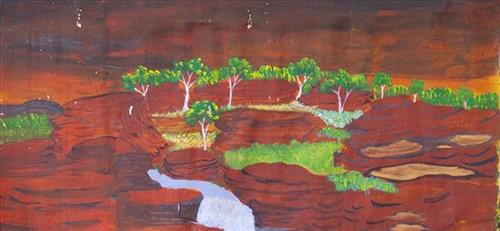111582095169
Katjarra
“This is my father’s Country; this is where my grandfather and grandmother come from. Katjarra is homeland for Putijarra, it’s their ngurra (home Country, camp). This is where pujiman (traditional, desert dwelling) Martu used to live a long time ago. Most of them pass[ed] away and are buried there. Some of them left and went looking for their families in Wiluna and Jigalong. Long, long time ago, the old Martu people used to roam this Country. They used to sleep in the caves away from the wind and the rain of winter.
Katjarra is well known as a sacred area, no mining companies can’t do any mining round Katjarra because the oldies say the sites are not to be destroyed.”
– Noreena Kadibil
Katjarra (Carnarvon Range) mountain ranges are part of Noreena’s ngurra (home Country, camp). The mountain range, distinctive from a distance for its blue hue, is located in the south western corner of Birriliburu Indigenous Protected Area. This region lies at the southern end of Martu Country and at the intersection of the Little Sandy and Gibson Deserts of Western Australia. Katjarra was an important camping place for Martu walking between Jigalong and Wiluna for law business up until the late 1960s, as well as Martu who walked the Canning Stock Route into Wiluna. Katjarra was also the site of the 2008 Birriliburru Native Title Determination, one of the first land grants to Martu.
Within the Katjarra mountain range are many water sources, including a culturally significant creek close to Milyinirri (Canning Stock Route Well 6), also named Katjarra. This creek is home to an ancestral rainmaking jila (snake), and its waters cascade down the hill from here. The Western Desert term jila is used interchangeably to describe springs considered to be ‘living’ waters and snakes, both of which play a central role in Martu culture and Jukurrpa (Dreaming). During the pujiman period, knowledge of water sources was critical for survival, and today Martu Country is still defined in terms of the location of water sources. Of the many permanent springs in Martu Country, very few are ‘living waters’; waters inhabited by powerful ancestral snakes. Before they became snakes, these beings were men who made rain, formed the land and introduced cultural practices like ceremonies and ritual songs. Some of the men travelled the desert together, visiting one another, but they all ended their journeys at their chosen spring alone, transformed into a snake. These important springs, like Katjarra, are named after their jila inhabitant.
Katjarra also features as a site in the Minyipuru (Jakulyukulyu, Seven Sisters) Jukurrpa, and that of the yalapara (perentie goanna), an ancestral goanna being who was responsible for the creation of many significant land features in the area.




